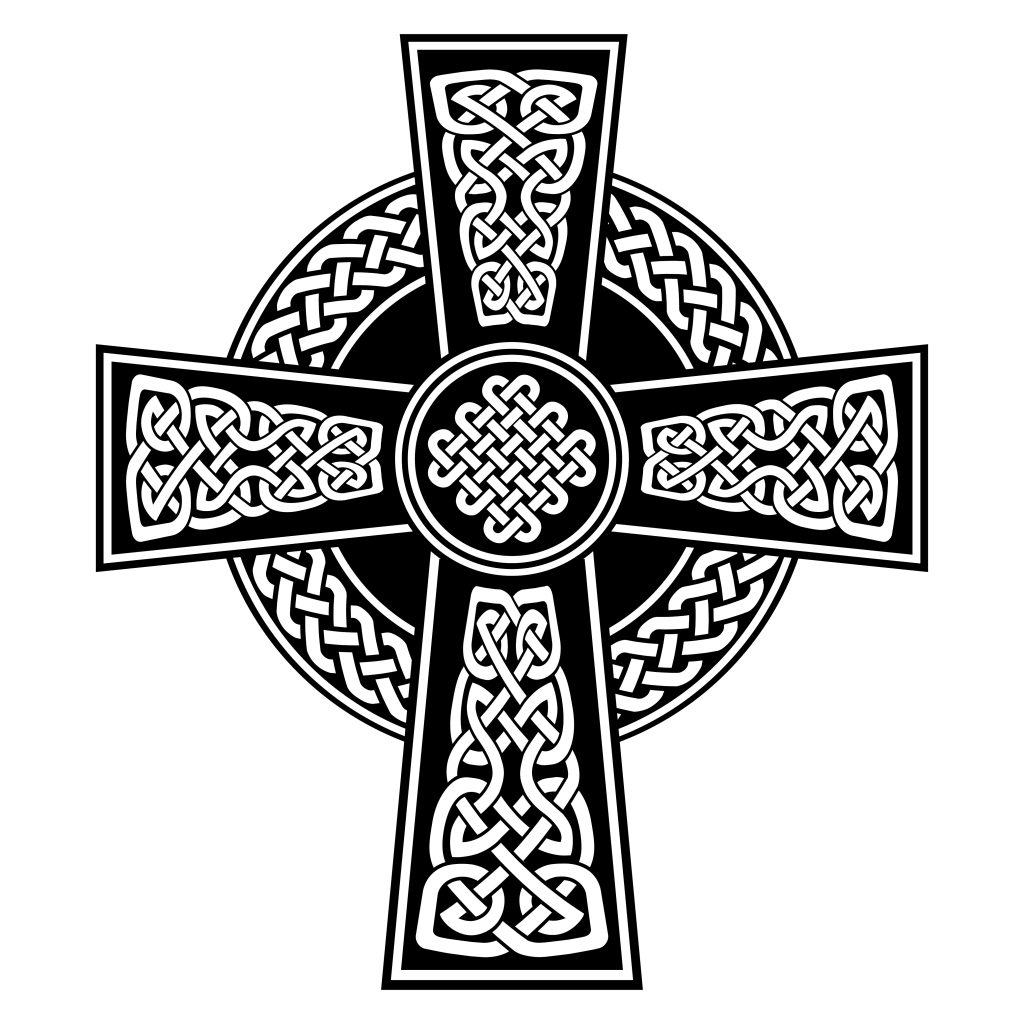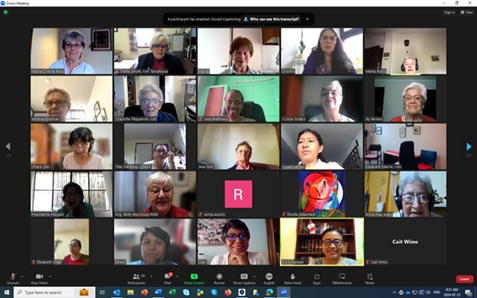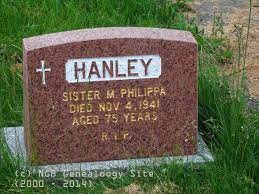Margaret O’Farrell was born in County Tipperary in November of 1841, the only daughter of Mary and Patrick O’Farrell. She arrived in St. John’s on March 17,1865 to enter the Sisters of Mercy.
 At her reception into the Novitiate on August 2 of that same year she received the name Sister Mary Patrick Ligouri. A local newspaper, The Newfoundlander, in its August 3,1865 issue, reported on her Reception Ceremony, noting that a couple of her brothers “our respected townsmen, the Messrs. Farrell” had emigrated to Newfoundland from Ireland and were well established in the business community of St. John’s by the time their sister arrived.
At her reception into the Novitiate on August 2 of that same year she received the name Sister Mary Patrick Ligouri. A local newspaper, The Newfoundlander, in its August 3,1865 issue, reported on her Reception Ceremony, noting that a couple of her brothers “our respected townsmen, the Messrs. Farrell” had emigrated to Newfoundland from Ireland and were well established in the business community of St. John’s by the time their sister arrived.
After her profession, Sister M. Patrick spent most of her religious life teaching at St. Bridget’s School in the east end of St. John’s and at St. Peter’s School on Queen Street. Both of these schools were under the care of the Sisters at Mercy Convent and the sisters would have made the daily walk to and from school in all kinds of weathers.
In August of 1884 Sister M. Patrick’s niece, Mary O’Farrell (later known as Sister Genevieve) arrived in St. John’s to enter the Sisters of Mercy. Sister M. Patrick had left Ireland before Mary had been born. Sadly, the two had little opportunity to spend much time with one another, as Sister M. Patrick died on May 10, 1885. Her obituary notice in The Evening Telegram of May 18 1885 speaks of her as follows:
She ministered consolation to many a poor sick death-stricken family,
as well as imparted the gift of a religious education
to the destitute and the poor.
- Read more Sisters stories documenting our Newfoundland Mercy Story
Margaret O’Farrell nació en el condado de Tipperary en noviembre de 1841, hija única de Mary y Patrick O’Farrell. Llegó a St. John’s el 17 de marzo de 1865 para ingresar en las Hermanas de la Misericordia.
En su recepción en el noviciado, el 2 de agosto de ese mismo año, recibió el nombre de Hermana Mary Patrick Ligouri. Un periódico local, The Newfoundlander, en su edición del 3 de agosto de 1865, informó sobre su ceremonia de recepción, señalando que un par de sus hermanos “nuestros respetados vecinos, los señores Farrell” habían emigrado a Terranova desde Irlanda y estaban bien establecidos en la comunidad empresarial de St.
Después de su profesión, la hermana M. Patrick pasó la mayor parte de su vida religiosa enseñando en la escuela de Santa Brígida, en el extremo este de San Juan, y en la escuela de San Pedro, en Queen Street. Ambas escuelas estaban bajo el cuidado de las Hermanas del Convento de la Misericordia y las hermanas habrían hecho la caminata diaria hacia y desde la escuela en todo tipo de climas.
En agosto de 1884, la sobrina de la Hermana M. Patrick, Mary O’Farrell (más tarde conocida como la Hermana Genevieve) llegó a St. La Hermana M. Patrick había dejado Irlanda antes de que naciera Mary. Lamentablemente, las dos tuvieron pocas oportunidades de pasar mucho tiempo juntas, ya que la Hermana M. Patrick murió el 10 de mayo de 1885. Su nota necrológica en The Evening Telegram del 18 de mayo de 1885 habla de ella de la siguiente manera:
Consoló a muchas familias pobres, enfermas y afligidas por la muerte,
así como impartió el don de una educación religiosa
a los indigentes y a los pobres.
- Lea más historias de Hermanas que documentan nuestra Historia de Misericordia de Terranova


 She was received into the novitiate and given the name Sister M. Camillus Joseph on the feast of Our Lady of Mercy in the same year. Her novitiate companions were Sister M. Ligouri Carmody and Sister M. Ignatius Guinane, two young women from Limerick, Ireland, along with another Newfoundlander, Sister M. Clare Tarrahan, who haentered the community a year earlier.
She was received into the novitiate and given the name Sister M. Camillus Joseph on the feast of Our Lady of Mercy in the same year. Her novitiate companions were Sister M. Ligouri Carmody and Sister M. Ignatius Guinane, two young women from Limerick, Ireland, along with another Newfoundlander, Sister M. Clare Tarrahan, who haentered the community a year earlier. Mary Ellen’s religious name was Sister Mary de Chantal, a name that became legendary over her nearly sixty years of Mercy ministry in Newfoundland. In September 1961, less than a year after her Profession of Vows, Sister M. de Chantal went to Brigus as a member of that founding community. In 1866 she became Superior of Mercy Convent in St. John’s, the second sister to hold that position since the death of Sister Francis Creedon. During her time of office, two new Mercy foundations were established – Conception Harbour and Petty Harbour. In 1861 she went to Burin as Superior of St. Anne’s Convent.
Mary Ellen’s religious name was Sister Mary de Chantal, a name that became legendary over her nearly sixty years of Mercy ministry in Newfoundland. In September 1961, less than a year after her Profession of Vows, Sister M. de Chantal went to Brigus as a member of that founding community. In 1866 she became Superior of Mercy Convent in St. John’s, the second sister to hold that position since the death of Sister Francis Creedon. During her time of office, two new Mercy foundations were established – Conception Harbour and Petty Harbour. In 1861 she went to Burin as Superior of St. Anne’s Convent.
 She spent the early years of her religious life at St. Michael’s Convent, Belvedere and in 1904 was assigned to St. Bride’s Academy, teaching student teachers and senior students. Four years later she was transferred to Sacred Heart Convent in St. Lawrence, where she endeared herself to both students and parents. Upon her return to Belvedere in 1910 she took on the responsibilities of superior and novice mistress.
She spent the early years of her religious life at St. Michael’s Convent, Belvedere and in 1904 was assigned to St. Bride’s Academy, teaching student teachers and senior students. Four years later she was transferred to Sacred Heart Convent in St. Lawrence, where she endeared herself to both students and parents. Upon her return to Belvedere in 1910 she took on the responsibilities of superior and novice mistress.
 Irish-born Jane Fox arrived in St. John’s on October 21, 1881 to join the Sisters of Mercy, was received as Sister M. Joseph in March of 1882 and made profession of vows in April of 1884. She spent most of her religious life at Mercy Convent on Military Road, first teaching at Angels’ Guardian School and then at
Irish-born Jane Fox arrived in St. John’s on October 21, 1881 to join the Sisters of Mercy, was received as Sister M. Joseph in March of 1882 and made profession of vows in April of 1884. She spent most of her religious life at Mercy Convent on Military Road, first teaching at Angels’ Guardian School and then at